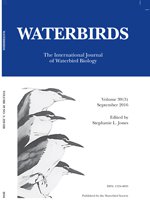The King Rail (Rallus elegans) is a secretive marsh bird of conservation concern. Reproductive success is thought to be a limiting factor for the inland migratory population. Reproductive effort of King Rails was studied in southeastern Oklahoma, USA, from 2010–2012 using surveys, radio-telemetry, nest searching and brood observations. During 2011–2012, 27–29 King Rail territories were documented. Ten nests were located between the first week in April and the first week in July with a mean clutch size of 10.3 (SE = 0.80). Water depth at nests was shallow (< 15 cm), and nest sites were in locations with more visual obstruction, more microtopographic variation, and more woody stems, while open water cover was less than at random sites. Nine broods were followed and were found to use rearing sites that were in deeper water and had a greater percent of tall emergent vegetation and more woody vegetation than random sites. Brood size dropped from an average of nine to two chicks by the second week. Weekly brood survival rate was 0.87 (SE = 0.045), which resulted in a 29% probability of greater than one chick surviving to fledge at 9 weeks. Increasing reproductive success is a management concern for this inland migratory population of King Rails.
How to translate text using browser tools
1 September 2016
King Rail (Rallus elegans) Nesting and Brood-Rearing Ecology in a Managed Wetland in Oklahoma, USA
David G. Krementz,
Karen L. Willard,
J. Matthew Carroll,
Katie M. Dugger

Waterbirds
Vol. 39 • No. 3
September 2016
Vol. 39 • No. 3
September 2016
chick survival rate
clutch size
habitat use
King Rail
Oklahoma
Rallus elegans




